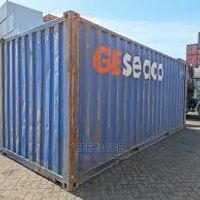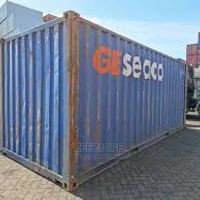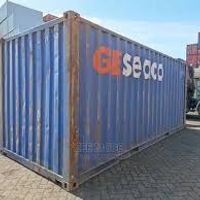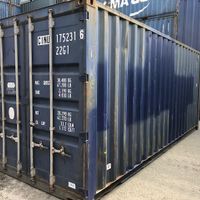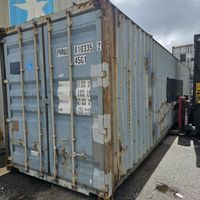If you want to send your cargo by Suez Canal shipping and want to know about the latest happenings, our blog can be your guide. Here we give you current news and updates and also help you secure a container at competitive rates from vetted suppliers to send it across the Suez Canal.
The Suez Canal is the fastest and shortest sea route between Asia and Europe (Atlantic and Indian Ocean via the Red Sea). Using this route you can get your cargo to its destination faster and help cut down on shipping emissions, thanks to shortened travel time.
If you’re looking for a container to ship across the Suez Canal, our online neutral marketplace can help you find containers in 2,500+ locations globally within seconds from vetted members. You can also find good deals by comparing and negotiating prices – thanks to our complete market price transparency.
Do you want to find the best container deals on your chosen route? Simply use the public search below to browse and compare offers right now! Type in the container type and location, then hit the search button to get started. This will show you all the available containers that you can source from vetted suppliers at competitive rates. Try it below!
10,382 results found on the platform.
Container prices start from $350/unit.
Currently no match for your search
Change your search criteria or fill out the form below to get notified via email when there is a new match for you on xChange!
-
Pick-up
20DC (Cargo worthy)
37 units available
YOM:
Year of manufacture:
2004
2010
Savannah, GA
per container
Non-negotiable price$
925
-
Pick-up
40HC (Cargo worthy)
4 units available
YOM:
Year of manufacture:
2004
2010
Los Angeles, CA
per container
Non-negotiable price$
1650
-
Pick-up
40HC (Cargo worthy)
7 units available
YOM:
Year of manufacture:
2004
2010
Chicago, IL
per container
Non-negotiable price$
1700
-
Pick-up

20DC (Cargo worthy)
10 units available
YOM:
Year of manufacture:
2004
2008
Lyon
per container
Negotiable price$
1800
-
Pick-up
40HC (Wind and water tight)
31 units available
YOM:
Year of manufacture:
2004
2006
Chicago, IL
per container
Non-negotiable price$
1000
Showing 5 of 10,382 results
Load more()
YOM:
Year of manufacture:
per container
$
What is the latest update on the Suez Canal?
Currently, there are three major Suez Canal news developments:
- An increase in transit fees, especially on the head-haul trade from Asia to Europe.
- The never-ending Panama Canal drought caused daily transits through this channel to decrease. So, instead of going trans-Pacific, any movement of goods to the US is now going around India through the Suez Canal across the Atlantic and into the US.
- The Israel-Palestine conflict poses risks to key shipping routes, including the Suez Canal and the Strait of Hormuz. The extent of its impact in 2024 depends on the conflict’s scope and duration, adding further uncertainty to the shipping industry. Read our blog on Red Sea shipping to get the latest updates on the ship attacks, so you are prepared before you set sail.
Out of all these updates, the one that takes the cake regarding business spending is the rise in the Suez Canal transit fees. Hence, to explore this further you need a better understanding of the Suez Canal Authority. We will explain that to you along with the fee hike details in the section below.
Suez Canal Authority and transit fees
Suez Canal Authority (SCA) is an Egyptian state-owned authority that owns, manages, operates, and maintains the Suez Canal. It’s this governing body alone that exclusively issues and keeps in force the rules of navigation in the Suez Canal and other rules and regulations that provide for the orderly functioning of the Suez Canal.
The Suez Canal Authority announced that it will raise the transit fees for ships passing through the Suez Canal by 5-15%, effective 15 January 2024.
The 15% rise in transit fees will apply to the following types of ships:
- Container ships
- Crude Oil Tankers
- Petroleum Product Tankers
- Liquefied Petroleum Gas (LPG) Carriers
- Liquefied Natural Gas (LNG) Carriers
- Chemical tankers and other liquid bulk tankers
- Vehicles Carriers
- Cruise Ships
- Special Floating Units
And the 5% rise in transit fees will apply to:
- Dry Bulk Vessels
- General Cargo Vessel
- Roll-On/Roll-Off (RO/RO) Vessels
How much does it cost to cross the Suez Canal?
Along with the 15% rise in Suez Canal fees for container ships, there are other costs related to vessel transit through the Suez Canal. These costs vary depending on factors such as the vessel’s size, type, tonnage of the vessel and the kind of cargo being carried.
Additional costs are charged for drafts over 14.3 meters, beams wider than 66.4 meters, and garbage dues if the ship needs to offload waste ashore. Plus, mandatory payments are charged for port fees, pilotage, mooring, and ministry fees.
Let’s take an example to give you a clearer idea. Say a bulk carrier carrying about 33,000 gross tonnage is sailing from Asia to Europe through the Suez Canal. The cost for this will be as follows:
- Transit fee for the bulk carrier needed for bulk shipping– $300k to $500k
- Port dues- $3000
- Port Authority fees -$700
- Ministry fees- $6575
- Mooring fees- $2590 mooring fees
- Garbage dues- $100 (Not compulsory. Only applicable if the vessel is required to land garbage ashore).
- Escort tugs -$14,150 escort tugs
- Light dues- $10,360
- Suez Canal Authority dues- $444,000
Note: The above rates are just an estimation used for the example after researching costs across the Suez Canal and not actual rates.
Totaling to $484,035. It’s a costly affair! What doesn’t have to be costly though is sourcing a container for your Suez Canal move. Find competitive, comparable, and negotiable rates with no hidden fees on 50,000+ boxes on our platform today.
Buy or lease containers at top deals to ship across the Suez Canal
With a complete understanding of the latest Suez Canal update and how much this journey will cost, you can now head to Container xChange’s neutral marketplace to buy or lease containers you want to send across the Suez Canal.
We have 50,000+ containers up for sale with full market price transparency. You get competitive and comparable rates upfront on one dashboard. These rates can be negotiated with your supplier before you choose a deal that works best for you. There are also different container types and container conditions available for your use.
If you want to lease a container, in particular, we recommend using SOC containers. Why? Because SOCs can help you save up on Demurrage and Detention. This is because when you lease SOC containers from shippers, you’re under no obligation to pay demurrage and detention charges to carriers. So in case of a delay through the Suez Canal, you’re safe from paying these fees.
Access all these benefits under one single platform! Take the right step towards simplifying your logistics operations with xChange by clicking on the banner below.
What is the Suez Canal transit time?
Suez Canal transit time cuts the 24-day journey from Asia to Europe to just 11 to 16 hours. This transit time however can vary depending on several factors, including the size and type of ship, the traffic in the canal, and the weather conditions.
One such infamous Suez Canal incident that caused a significant delay in the otherwise quick transit journey was in 2021. In March of 2021, ‘Suez Canal blocked’ and ‘Suez Canal ship stuck’ were the 2 major headlines of almost all news channels. During this time the Suez Canal was blocked for six days by the mega container ship, Ever Given that had run aground in the canal. This led to a significant hindrance to global trade and increased transit times through the route.
Lucky, that’s all in the past now and you can get your cargo to Europe at lightning speed right away by securing your unit on our platform from 1,500+ vetted suppliers.
Find your container from vetted suppliers to send through the Suez Canal only on Container xChange
Whether you want to buy or lease boxes for the journey across the Suez Canal you’ll only find vetted and certified suppliers to source containers for your route. That’s because all members on the platform go through a mandatory vetting process to ensure your safety. You can also view the profiles of companies and see the ratings and reviews given to them by their partners and decide whom you want to work with. With us, you’ll get 1,500+ container suppliers across 2,500+ locations worldwide.
You can grow your business networks by connecting directly with big names such as Seaco Global, Trident, SeaCube, and other trusted names on the platform without a middleman. How? We have a chat and a call feature you can use on the platform to reach out directly to the company that you like to negotiate deals and terms with.
You can keep your transactions safe with the xChange Wallet which sends you one consolidated bill at the end of each month to make your transactions easy and efficient. Also, after you’ve secured your box and sent it through the Suez Canal, you can keep track of it with our near real-time container movement tracking feature that gives you ETAWhat is estimated time of arrival? Estimated time of arrival, commonly known as ETA, is a frequently used term globally to denote the time of coming. In the shipping & logistics industry, it is ... More updates and alerts on delays, container rollovers, and more.
Don’t wait any longer, get started today by cruising through our neutral marketplace to buy or lease a box of your liking by clicking the banner below.
Suez Canal shipping: Common FAQs
Which country owns the Suez Canal?
The Suez Canal Authority (SCA) is an Egyptian state-owned authority that owns, manages, operates, and maintains the Suez Canal.
What two countries does the Suez Canal connect?
The Suez Canal connects Asia to Europe through the Atlantic and Indian Ocean via the Red Sea.
Why do ships go through the Suez Canal?
Ships go through the Suez Canal to transport goods from Asia to Europe.


